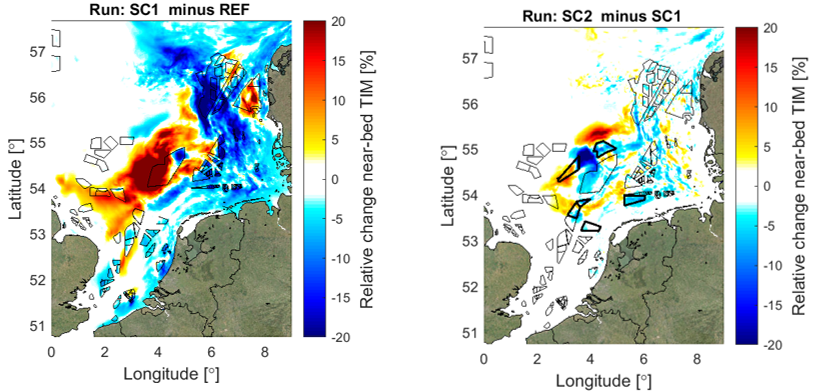Luka Jaksic1*, Thijs van Kessel1, Vincent van Zelst1,2, Firmijn Zijl1, Natalia Aleksandrova1, Stendert Laan1, Leo Leummens1, Tammo Zijlker1, Lauriane Vilmin1, Lisa Schneider1, Luca van Duren1
1 Deltares, P.O. Box 177, 2600 MH Delft, The Netherlands; 2 Delft University of Technology, Faculty of Civil Engineering and Geosciences, P.O. Box 5048, 2600 GA Delft, The Netherlands.
*corresponding author:
Introduction
Upscaling wind-energy capacity in the North Sea is considered an important step in the energy transition. The aim of the Dutch government is to speed up the development of offshore wind and to realise 21GW offshore wind capacity by 2030. These developments come also with known direct adverse effects such as collision risk for birds, habitat loss of seabirds and effects of noise on marine mammals and effects of electromagnetic fields from cables on benthos and fish. However, indirect effects, via physical and ecological processes, have been underexposed. Within the WOZEP programme knowledge gaps regarding ecosystem effects of large-scale offshore wind farms in the North Sea are assessed.
Methods
To assess potential ecosystem effects, the 3D Dutch Continental Shelf Model in Flexible Mesh (3D DCSM-FM; Zijl et al., 2021) has been extended with a wave, fine sediment and ecological module. This validated integrated online coupled flexible mesh model allows to assess large-scale domains.
Results
Large-scale extraction of wind energy from the atmosphere affects local wind patterns, wave generation, tidal amplitudes, stratification and consequently fine sediment dynamics. Such physical changes have consequences for the ecological functioning of the North Sea. Changes in the vertical stratification of suspended sediment concentration (SSC), for example, affect both the nutrient and light availability. On a North Sea scale, the numerical model results show that the enhancing and reducing effects of offshore wind farms on SSC partially cancel out. However, our results also suggest that persistent changes may occur at regional scales, such as a significant decrease in SSC flux in the Dutch coastal zone. These effects become more pronounced for hypothetical upscale scenarios up to 70GW capacity in 2050. Wind farming in the North Sea has effects at a scale beyond that of single wind farms. These effects on the physical environment and ecosystem functioning should be considered and if needed mitigated to prevent large-scale side effects.

Figure 1: Changes in year-average, near-bed total inorganic matter (TIM) for future wind park scenarios 1(left) and 2 (right) in 2050.
References
Zijl, F., Laan, S., Groenenboom, J. (2021). Development of a 3D model for the NW European Shelf (3D DCSM-FM). Deltares, report 11205259-015-ZKS-0003, Delft.
I. Surname1*, F.N. Another-Surname2 , Y. Next-Surname2
1 University Name, Country; 2 Organization Name, Country
* Corresponding author: mail.name@organization.org


